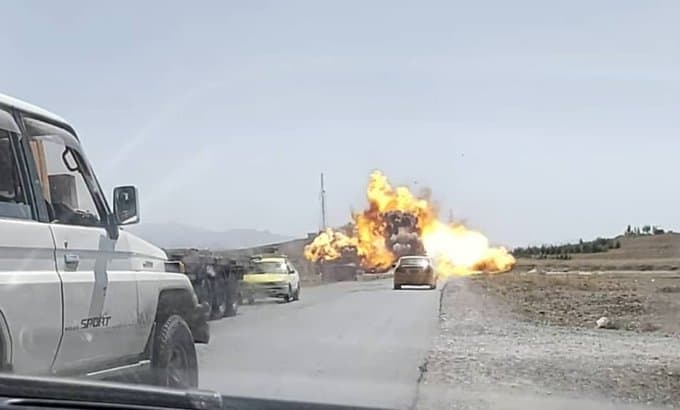
The Taliban killed at least 10 people, including an American and a Romanian soldier, and wounded 42 more in a suicide bombing near a National Directorate of Security checkpoint in the Afghan capital of Kabul today. Today’s attack in Kabul is the latest in a series of recent Taliban operations across the country, including assaults on two provincial capitals, an international compound in Kabul, and the assassination of a key commander in Badakhshan. This wave of Taliban attacks takes place as the US considers signing a withdrawal deal with the terror group.
The Taliban proudly claimed credit for today’s “powerful martyr attack” which targeted “a convoy of foreign invaders in the front gate of NDS Directorate 40.” The Taliban, which routinely inflates the casualties caused by its operations, claimed that “12 invaders along with 8 Kabul intelligence agency operatives” were killed. Most of the victims were Afghan civilians.
Today’s suicide attack in Kabul is the second in the capital in three days. On Sept. 3, a Taliban suicide bomber killed 16 people, including eight foreign nationals (“five Nepalese, two British and Romanian nationals,” according to TOLONews) and wounded 119 more. The Taliban claimed a four man suicide assault team entered a breach at the Green Village, a compound that houses multiple international companies, that opened up by the suicide bomber, and killed security personnel and civilians during a 12 hour long firefight.
Meanwhile, last weekend, the Taliban launched military offensives against the Kunduz City and Pul-i-Khurmi, the provincial capitals of Kunduz and Baghlan respectively. While both assaults were ultimately repelled, the Taliban made advances inside both cities. In Pul-i-Khurmi, the Taliban appeared to have come within hundreds of yards of the district center and briefly took over a prison and hospital. Fighting is reported to be ongoing in some neighborhoods on the outskirts of the city.
Kunduz City has been assaulted and taken over by the Taliban two other times since 2015. In its latest attack, the Taliban took over areas of the city and forced a group of Afghan soldiers to surrender before withdrawing. A suicide bomber killed 10 Afghan soldiers and civilians, including the spokesman for the city’s police.
In Badakhshan, the Taliban killed General Niazi, an influential commander who lead the province’s anti-Taliban militia, which is comprised of upwards of 4,000 fighters. The Taliban has made inroads in Badakhshan over the past four years; most of the province’s districts are contested or controlled by the Taliban. Niazi was considered to be a key leader who could help organize the provinces’ last line of defense.
In Balkh province, the Taliban claimed it overran the district of Zari. Afghan officials dispute this, however heavy fighting is taking place in the district. Zari district was previously considered to be firmly under the government’s control. FDD’s Long War Journal now assesses Zari as contested. The Taliban now controls at least 66 of Afghansitan’s 407 districts, and contests another 193.
The attacks in Kabul, Kunduz, Baghlan, and Badakhshan are by no means the only operations by the Taliban in the country. There have been numerous reports of fighting in other provinces over the past week.
This wave of Taliban attacks takes place as the U.S. is considering signing a so-called peace deal with the Taliban. U.S. Secretary of State is reportedly hedging on signing the agreement, which would refer to the Taliban as the Islamic Emirate of Afghanistan, TIME reported yesterday.
The Islamic Emirate of Afghanistan is the name of Taliban’s government from 1996 to 2001. The Taliban still refers to itself as the Islamic Emirate of Afghanistan, and has been clear in its propaganda that it seeks to rule all of Afghanistan.
According to TIME, the agreement “doesn’t guarantee the continued presence of U.S. counterterrorism forces to battle al Qaeda, the survival of the pro-U.S. government in Kabul, or even an end to the fighting in Afghanistan.”
The Taliban’s military and political actions during the past several months makes it clear that the return of the Islamic Emirate is its primary goal, and not peace.







